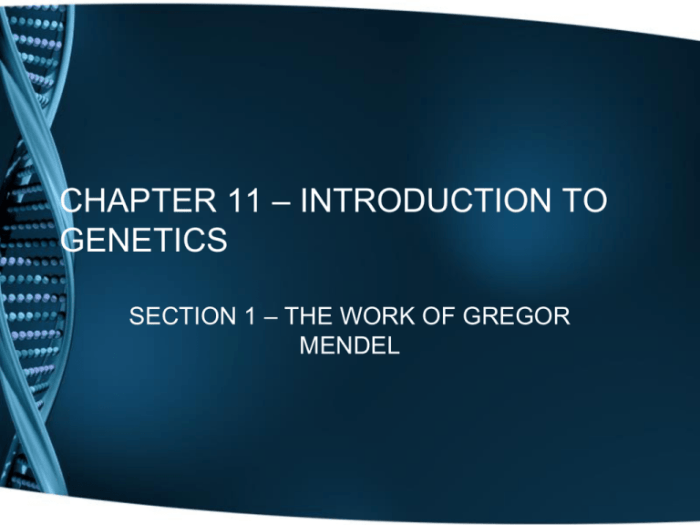Chapter 11 introduction to genetics – Chapter 11: Introduction to Genetics embarks on a captivating journey into the realm of heredity, where we delve into the fundamental principles that govern the transmission of traits from one generation to the next. This chapter provides a comprehensive overview of the field of genetics, tracing its historical roots to Gregor Mendel’s groundbreaking experiments and exploring the cutting-edge advancements of modern molecular genetics.
Through a series of engaging and accessible explanations, we will uncover the basic principles of Mendelian inheritance, unravel the intricate structure and function of DNA, and delve into the processes of gene expression and genetic variation. By the end of this chapter, readers will gain a deep understanding of the fundamental concepts of genetics and its profound implications for our understanding of life itself.
1. Introduction to Genetics
Genetics is the study of inheritance, variation, and evolution. It is a branch of biology that deals with the transmission of traits from parents to offspring.
The history of genetics can be traced back to the experiments of Gregor Mendel in the mid-19th century. Mendel’s work on pea plants laid the foundation for our understanding of inheritance. He discovered that traits are passed down from parents to offspring in a predictable manner, and that the inheritance of each trait is determined by a pair of genes.
Basic Principles of Mendelian Inheritance
- Dominant and Recessive Alleles:Each gene has two copies, one inherited from each parent. If the two copies are the same, the individual is homozygous for that gene. If the two copies are different, the individual is heterozygous for that gene. The allele that is expressed in the phenotype is called the dominant allele.
The allele that is not expressed in the phenotype is called the recessive allele.
- Genotypes and Phenotypes:The genotype of an individual is the combination of alleles that they have for a particular gene. The phenotype of an individual is the observable expression of their genotype.
2. The Structure and Function of DNA
DNA (deoxyribonucleic acid) is a molecule that contains the genetic instructions for an organism. It is found in the nucleus of cells and is made up of four different types of nucleotides: adenine (A), thymine (T), cytosine (C), and guanine (G).
The structure of DNA is a double helix, which means that it is made up of two strands that are twisted around each other. The nucleotides in each strand are paired together by hydrogen bonds, with A always pairing with T and C always pairing with G.
Role of DNA in Storing and Transmitting Genetic Information
DNA stores the genetic information that is necessary for an organism to develop and function. This information is encoded in the sequence of nucleotides in the DNA molecule. When a cell divides, the DNA molecule is copied so that each new cell has a complete copy of the genetic information.
3. Gene Expression: Chapter 11 Introduction To Genetics

Gene expression is the process by which the information in DNA is used to produce proteins. The first step in gene expression is transcription, which is the process of copying the DNA sequence into a messenger RNA (mRNA) molecule.
The mRNA molecule is then transported out of the nucleus and into the cytoplasm, where it is translated into a protein. Translation is the process of reading the mRNA sequence and using it to assemble the correct sequence of amino acids in the protein.
Regulation of Gene Expression
Gene expression is regulated by a variety of factors, including transcription factors and other regulatory elements. Transcription factors are proteins that bind to specific DNA sequences and either promote or inhibit transcription.
4. Genetic Variation
Genetic variation is the presence of differences in DNA sequences between individuals. This variation can be caused by mutations, recombination, or gene flow.
Mutations are changes in the DNA sequence that can be caused by a variety of factors, including environmental toxins and errors in DNA replication. Recombination is the process of exchanging genetic material between chromosomes. Gene flow is the movement of genes from one population to another.
Role of Genetic Variation in Evolution and Human Health
Genetic variation is essential for evolution. It provides the raw material for natural selection to work on. Natural selection is the process by which individuals with traits that are better suited to their environment are more likely to survive and reproduce.
Genetic variation also plays a role in human health. Some genetic variations can increase the risk of developing certain diseases, while others can provide protection against disease.
5. Genetic Technologies

Genetic technologies are tools that are used to study genes and genomes. These technologies include DNA sequencing, PCR, and microarrays.
DNA sequencing is the process of determining the order of nucleotides in a DNA molecule. PCR (polymerase chain reaction) is a technique that is used to amplify a specific region of DNA. Microarrays are used to measure the expression of multiple genes simultaneously.
Applications of Genetic Technologies, Chapter 11 introduction to genetics
Genetic technologies have a wide range of applications in medicine, agriculture, and other fields. In medicine, genetic technologies are used to diagnose and treat diseases, and to develop new drugs and therapies.
In agriculture, genetic technologies are used to improve crop yields and resistance to pests and diseases. In other fields, genetic technologies are used to study human evolution, to identify criminals, and to solve paternity disputes.
Ethical and Social Implications of Genetic Technologies
The use of genetic technologies raises a number of ethical and social concerns. These concerns include the potential for genetic discrimination, the misuse of genetic information, and the impact of genetic technologies on human evolution.
Expert Answers
What is the central dogma of molecular biology?
The central dogma of molecular biology describes the unidirectional flow of genetic information from DNA to RNA to protein.
What is the difference between a genotype and a phenotype?
A genotype refers to the genetic makeup of an individual, while a phenotype refers to the observable traits that result from the expression of that genetic makeup.
What are the different types of genetic mutations?
Genetic mutations can be classified into various types, including single nucleotide polymorphisms (SNPs), insertions and deletions (INDELS), and copy number variations (CNVs).
